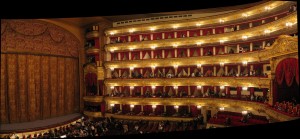‘Mimesis’ and ‘Diegesis’ are two terms from drama and narrative theory that I tend to use a lot, so I thought I’d take a moment to explain them here.
To put it simply, both mimesis and diegesis describe ways of presenting a story. In mimesis, the story is acted out. In diegesis, the story is narrated. Mimesis is show. Diegesis is tell.
Most film and television stories are mimesis. The audience and the actors are engaged in an elaborate game of pretend—a contract that expects the actors to behave as if they really are the character. The audience, for their part, is invited to suspend their disbelief, to forget the many layers of artifice and experience the story as if was in some way real. The film or program may help this with powerful, believable acting, a spectacle of special effects and convincing costume. These great efforts are expended because, for the audience to have an emotional experience arising from the mimesis, they need a sense of authenticity. They need to trust and believe that what they are seeing is, after a fashion, a reality.
The phenomenon is even more interesting in theatre. The lights drop, the curtains rise, and once again audience and performers are united in an artistic pact. On the one side, the performers portray a playwright’s script as if the memorised lines were spontaneous and their own. On the other side of the fourth wall, the audience act as if they were not sitting in a crowd of acquaintances. Instead, they almost behave as if they themselves do not exist. They become part of the play of theatre, the game whereby backdrops and props indicate and create an imaginary world. If the game is well done the audience’s experience of that world can be as profound, ecstatic or cathartic as anything the real world can offer. If you’re willing to wave that fake knife around as if you really mean it, the audience member unconsciously agrees, I’ll feel a real sense of dread that you’ll stab King Duncan.
But Mimesis asks more of its audience than simply to believe in an imaginary world. Indeed, all narrative invites the listener into an imaginary world. The distinctive feature of mimesis is that the audience experiences the story as playing out in front of them. The imaginary world does not exist at a distance—it is neither long ago nor in a galaxy far away, it is on this screen, this stage, immediate and immanent, for as long as the story takes.
Diegesis, in contrast, is pure narration. It is a story told, rather than acted. Novels provide an obvious example. A book may contain the tale of carnivorous horses on an alien planet, but at no point does C J Cherryh’s “Rider at the Gate” actually pretend to be any of those things. At no point will the pages bite at my fingers. (I should say that I am only up to page 217, so maybe there are surprises to come.)
Obviously as a storyteller I work almost entirely with diegesis. Between the “Once upon a time” and the “happily ever after.” I invite my listeners to join me on an imaginary journey, but I do not expect them to experience it as actually happening in front of them.
Diegesis, so the school children in Rainham explained to me when I introduced them to the term, requires you to use your imagination more than mimesis, and is more powerful as a result. There’s some truth in that:- the cinema of the mind has the most compelling of special effects, with artistry and budget constraints handed over to the listener. I remember talking to audience members about a particular monster from a Dovie Thomason story. One woman described how the monster was a childhood terror she knew from growing up, a thing that had lived in her garden pond, a creature of scales and teeth with murderous intentions. She marvelled at how Dovie had managed to bring to life this creature that had been buried under decades of memory. In truth, the detailed description of the monster that the listener was able to give hardly matched Dovie’s broad brush strokes at all. The teller had offered a canvas and the listener had painted their own deep fears. The diegesis is what is told and that means making critical decisions about what to leave untold.
Because it allows us to simply state outright the point we’re trying to convey in the story, Diegesis allows us to be more economical than mimesis. This character, I can say, was up all night worrying. The director has to show the character removing their glasses, rubbing their eyes, lines on their face. The script writer may even engineer a chance for a little exposition.
CHARACTER #2
Are you okay?
CHARACTER #1
(yawning)
Sorry, I was up all night worrying.
And yet having said this, there is an incredible power in the insight that mimesis requires of us. We end a scene with a character awake, pacing the room, night outside. We start a new scene with them slumped at a table, still dressed but now slightly unkempt, removing their glasses to rub at bleary, red eyes. On some deep level, the audience clicks. ah ha! they think, realising that time has passed They were up all night worrying. They still haven’t had any news. I bet they’re really tired. That insight into the underlying story is part of what makes mimesis enchanting. In many ways the greatest hook mimesis has is the way the audience creates the narrative from what they are shown. It is for this reason that so much creative advice boils down to “show and don’t tell.” It’s not just that the opposite leads to clumsy, exposition-heavy dialogue. It’s because of the enchantment of insight that draws the audience into a story well shown. Of course, it’s perfectly possible to leave space for insight in diegesis, in telling a tale, and there may well be another blog post about that in the future.
On the other end of the spectrum of economy, diegesis also allows us to take our time. A novel can linger over a character’s emotions, thoughts, memories, histories, perceptions and expectations in ways that mimetic artforms struggle to replicate. Indeed, it is one of the features of mimesis that it tends to take place in real time. There may be cuts between scenes, but when an actor recites a scripted line it takes them exactly as long as it takes their character. When they walk down a corridor and we watch them go, time in the world of the story and time in the world of the portrayal are in synch. Each second of screen time is a second of the audience’s time as well. How long does a novel linger over the space of a few seconds? As long as the author deems necessary. She is free from the tyranny of a constantly shifting now.
And there are further subtleties to both. Shakespeare loved a play within a play; mimesis within mimesis. A character in a play may tell a story; diegesis within mimesis. Likewise a storyteller may step into character stance, may speak in the character’s voice, and suddenly a little moment of mimesis occurs.
Beyond diegesis, the storyteller also has the option of talking to the audience directly. Ben Haggerty calls this “The language of commentary”, but then clarifies that everything, including for example the clothes the storyteller wears to tell their tale, is commentary on the story. I’m being a little more specific. I describe the act of a teller pausing in their narration to address the audience directly as stepping into “commentator stance.” It may be as brief as a knowing look toward the audience that says “we all know what’s going on here!” But it is outside the diegesis, in the world that the teller and the audience share, not the world of the story.
The truth, as is probably becoming clear, is that diegesis and mimesis are not distinct labels that can be exclusively applied to each narrative expression. They are a spectrum on which different artforms and performances exist at intervals. A graphic novel encompasses both in every panel. A film director who uses a voice over embeds a little diegesis in their work. A writer who summarises a whole conversations in a few lines rather than directly reporting the speech makes medium already strongly diegetic even more so by telling about the character’s words rather than showing them writ long.
Diegesis. Mimesis. That’s how I’ll be using the words here.


Leave a Reply